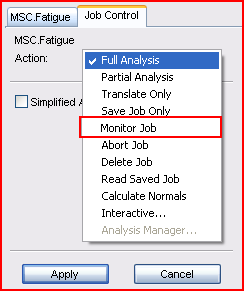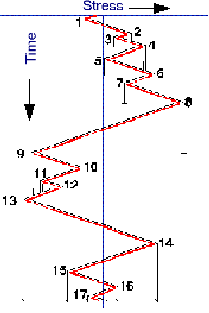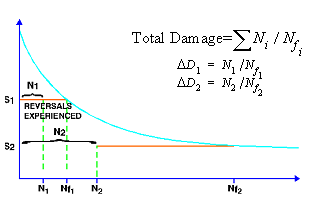XXXXXXXXXXXXXXXXXXXXXXXXXXXXXXXXXXXXXXXXXXXXXXXXXXXXXXXXXXXXXXXXXXXXXXXXXXXXXXXXXXXXXXXXXXXXXXXXXXXXXXXXXXXXXXXXXXXXXXXXXXXXXXXXXXXXXXXXXXXXXXXXXXXXXXXX''"> Run the Fatigue Analysis
You are ready to run the fatigue analysis. Open the Job Control... form, set the Action to Full Analysis and click the Apply button. The database will close momentarily as the results information is extracted. When the database reopens, the job will have been submitted. You can then set the Action to Monitor Job and click the Apply button from time to time to view the progress. When the message appears, the analysis is complete. Close down the Job Control... form when done.
Fatigue analysis completed successfully
Rainflow Cycle Counting
This analysis takes longer to run to completion than the previous example is due to the complex nature of the time signal. The program is performing a procedure called rainflow cycle counting, referred to as “preprocessing” in MSC Fatigue. Cycle counting is a mechanism to extract and count the number of stress cycles in a signal.
The term Rainflow is attributed to two Japanese gentlemen, Matsuishi and Endo, who invented the method. It is based on the concept of rain drops flowing off Japanese style pagoda roofs. Time history signals are stood on end and rain is visualized to run off of each peak or valley. Various rules were adopted to count cycles and reversals which is beyond the scope of this text; but suffice it to say that the end result of rainflow cycle counting is a set of constant amplitude signals and a count of the number of cycles in each. Cycle counts can be visualized as probability density functions (PDF) or as 3-dimensional histogram matrices as you will see later.
Damage Summation
It is important to break up a variable signal into a number of constant amplitude signals in order to assess the life from the S-N curve. The curve itself is created by a series of constant amplitude tests. So for each cycle in the signal you must look up the proper stress from the S-N curve. What stress to look up is the job of rainflow cycle counting. The next challenge to tackle is the summation of the damage from each cycle in order to report a total life due to all cycles. This is accomplished by way of the Palmgren-Miner linear damage summation law.
This states that damage can be summed by determining the ratio of the number of cycles experienced to the number of cycles to failure for a given stress range or level and then summing all the ratios for every stress range. When this number, known as Miner’s Constant, reaches unity, failure is said to have occurred. The predicted life is then determined by summing the percentage of life used by each stress level for the entire time signal. Life is then reported back as to the number of times the given time signal can be applied before failure.
Hint: | This is where user-defined fatigue equivalent units come in handy, because rarely does one want life reported in “repeats” of the time signal, but rather in more meaningful units such as hours, miles, years, laps, missions, etc. This is accomplished by defining these user-defined units in the PTIME, loading database manager, utility. Use the Change an entry | Edit details option. |
Speeding up the Analysis
There are two ways that you could speed up this analysis.
1. First, since we already know where the failure location will be (at the point of highest stress) because of the simplicity of this model, we could have defined a Group with only this node (Node 1) and specified it in the Materials Info... form. This however, would only calculate life at this one node and would ignore the rest of the model.
2. Second, on the Job Control... form you can turn on the Simplified Analysis toggle. As an exercise after you finish this problem, turn this toggle ON, change the Jobname to something else and re-run the problem. Note how much faster the analysis proceeds relative to the first time. What is happening is that for a normal analysis, the rainflow procedure is being applied to each location once its stress time variation is determined. When the Simplified Analysis toggle is turned ON, the rainflow procedure is applied to the loading time history first and the FE stresses are used to scale the rainflow histogram matrix. This speeds up the analysis significantly for a complex time signal for a single load. It does however, produce slightly less accurate results. Notice the slight variation in predicted life when you do this.



